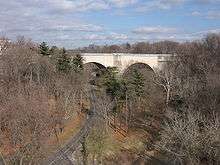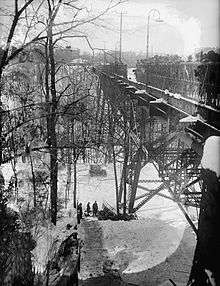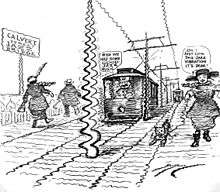Duke Ellington Bridge
| Duke Ellington Bridge | |
|---|---|
 The Duke Ellington Bridge as seen from the Taft Bridge | |
| Coordinates | 38°55′24″N 77°2′54″W / 38.92333°N 77.04833°WCoordinates: 38°55′24″N 77°2′54″W / 38.92333°N 77.04833°W |
| Carries | Calvert Street NW |
| Crosses | Rock Creek |
| Locale | Washington, D.C. |
The Duke Ellington Bridge, named after Duke Ellington, carries Calvert Street NW over Rock Creek in Washington, D.C., United States. It connects 18th Street NW in Adams Morgan with Connecticut Avenue NW in Woodley Park, just north of the Taft Bridge.
History
Originally called the "Calvert Street Bridge", it was designed by Paul Philippe Cret in a neoclassical style and built in 1935. It was rededicated as the Duke Ellington Bridge following the death of the Washington native and famous band leader in 1974.[1] It is a limestone structure with three graceful 146-foot (45 m) arches. There are four sculptural reliefs on the abutments measuring three feet high by four feet wide. The classical reliefs by Leon Hermant represent the four modes of travel: automobile, train, ship, and plane.

The bridge replaced one built in 1891 by the Rock Creek Railway to carry streetcars. The bridge was a steel trestle bridge with wooden decking, 750 feet (230 m) long and 130 feet (40 m) high. To avoid streetcar service disruption, the old bridge was moved 80 feet (24 m) south during the construction of the new replacement Calvert Street Bridge; however, streetcar service was discontinued before the new bridge opened.

See also
References
External links
| Wikimedia Commons has media related to Duke Ellington Bridge. |
- Duke Ellington Bridge, from Cultural Tourism DC
- Historic American Engineering Record (HAER) No. DC-23, "Calvert Street Bridge"
- Calvert Street Bridge at Structurae. Retrieved on 2012-12-24.